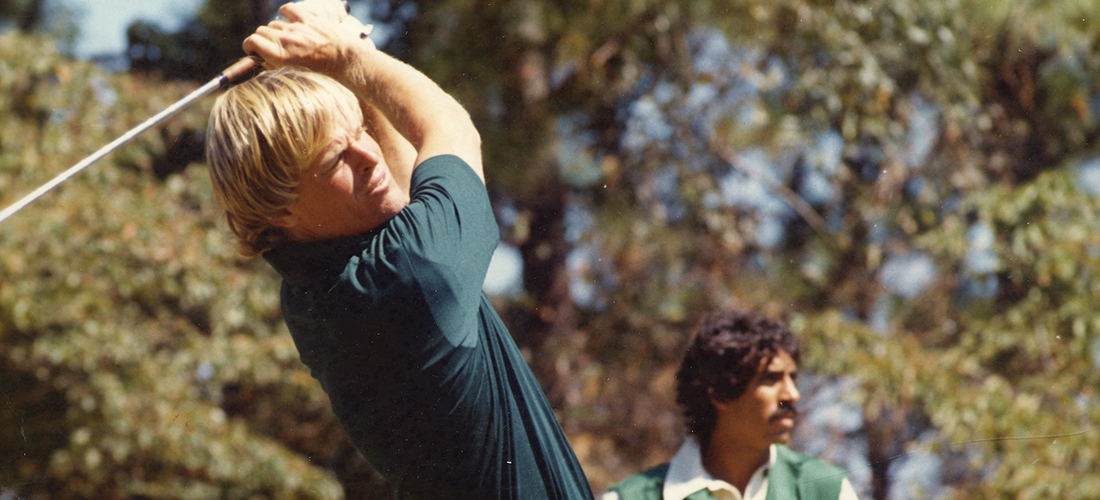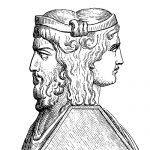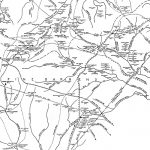
Miller Time
Pinehurst played a starring role
By Lee Pace
Johnny Miller is perhaps best remembered around Pinehurst for his stirring playoff victory over Jack Nicklaus and Frank Beard for the 1974 World Open title. That was the year the blond bombshell from Northern California scorched the PGA Tour with wins in three straight tournaments to open the season, took first in five others and banked $353,021. He drove the ball long and straight, smothered flagsticks with his irons and seemed to have magnets drawing his putts to the cup.
He’s also known in this golf-happy burg for his insight, candor and color he delivered for some three decades as a golf analyst for NBC. Now 71, Miller announced in October that he’d retire from broadcasting in early 2019 to spend more time with his family, which includes 24 grandchildren. Golfers coming in from their rounds at 4:30 on Sunday afternoon will see and hear Paul Azinger on NBC’s broadcasts instead.
“I’ve had two lives,” Miller said in breaking the news. “The golfing part . . . the younger generation sort of heard about me, but maybe didn’t realize I wasn’t too bad at times. Then the announcing part. But I’ve been on the road for 50 years.”
Still quite significant but virtually forgotten is that Pinehurst, in a sense, gave the world of golf the second coming of Johnny Miller. Four nostalgic days in the Colgate/Hall of Fame Classic in 1979 helped Miller shake a three-year slump and bounced him into a stretch in the early 1980s when he won five tournaments and finished among the Top 30 money earners four times. Miller didn’t win (Tom Watson beat him in a playoff), but he left town a champion in his own mind.
“That tournament single-handedly got me out of my slump,” Miller reflected years later. “It was like signaling to the rest of the PGA Tour that Johnny Miller could play golf again. It was a weight off my shoulders. Pinehurst’s been very good to me. I haven’t played it that many times, but it’s the kind of course I wish we played every week on the tour if I was still active.”
Miller was the incumbent U.S. Open champion with his mind-boggling 63 at Oakmont when the PGA Tour came to Pinehurst in November 1973 after a 22-year hiatus. Richard Tufts of the founding family discontinued the North and South Open in 1951 after financial squabbles with the tour pros, and Bill Maurer, the president of the new owners in the early 1970s, the Diamondhead Corporation, made it a priority to bring pro golf back to Pinehurst and its esteemed No. 2 course. He did so in the form of the 144-hole World Open, played over two weeks in November 1973 on the No. 2 and 4 courses. The purse was an unprecedented total of half a million dollars, with $100,000 to the winner (collected by Miller Barber). Miller entered the event but withdrew at the last minute because of an illness.
The following year, the format was trimmed back to 72 holes and was moved up to late September to coincide with the grand opening of the World Golf Hall of Fame, which sat for nearly two decades on ground to the east of the fourth green and fifth tee of the No. 2 course.
“The World Open in ’74 was the biggest money tournament of the year,” Miller said. “First prize was $60,000, which was unheard of at the time. Obviously, it was a big tournament and had a tremendous field. It was like a Players Championship of today.”
Miller shot a 63 in the second round, missing the course record 62s fired by Watson and Gibby Gilbert the year before. The round featured five birdies on the first six holes (including a 60-footer on the fifth hole).
“It was like one of those old Johnny Miller blitzes,” he said. “I dominated the course and scored a fairly easy 63, if there is such a thing.”
Miller and Nicklaus were tied at 209 after three rounds, with Charles Coody and Bruce Devlin two back and Bob Murphy and Beard trailing by three. The 27-year-old Miller, winner of $256,383 that year, reveled in the challenge of going head-to-head against the 34-year-old Nicklaus, who had earnings of $208,307 and a Tournament Players Championship that year.
“I wouldn’t be surprised if both of us shot in the 60s head-to-head,” Miller said after round three. “I’ve held him at bay recently and I’ve had a lot of success against Jack, but I don’t talk much about it. I know he’s a better player than I am, but I’m not afraid of him. He’s going to try to beat my brains out, but he’s got to respect me because I’ve had such great success against him.”
It turned out that Miller and Nicklaus each shot one-over 72s, allowing Murphy and Beard to force a four-way playoff with 69s and 281 totals, three-under for 72 holes (only eight players beat par for the tournament).
The playoff started on 15, where TV cameras were set up. Beard scored a routine par on the par-3, leaving a birdie putt dead short that could have ended it there. Miller and Nicklaus got up-and-down from the fringe, and Murphy was eliminated after his tee ball found a greenside bunker.
Miller won the tournament with a two-putt birdie on 16 after Beard three-putted and Nicklaus missed a 12-footer for birdie. Miller hit a 3-wood to eight feet — “The best shot under pressure I’ve ever hit,” he said — and went from thinking he had to make an eagle to simply needing to two-putt.
“To beat Jack Nicklaus in a playoff sort of capped off the year for me,” he said. “I enjoyed playing No. 2. It was perfect for my game. It gave you enough room off the tee, you had extremely difficult approach shots, and if you hit it real bad off the tee, you had broom grass, sand and trees. To me that course is the perfect course for my game. It’s the perfect test of golf because it’s got difficult putting, it accepts the approach shot fairly, and it penalizes the poor shot.”
A different Johnny Miller came to Pinehurst in 1979. He had been the talk of the tour in the early 1970s for his good play but now had become the talk of the tour for his bad play. He slid to 48th on the money list in 1977 and 111th in 1978, with only $17,400 in winnings. Miller hadn’t won a tournament since early 1976.
“What’s wrong with Johnny Miller?” the world wanted to know.
Miller responded that there wasn’t anything wrong that a bunch of birdies and a little confidence couldn’t solve.
“Before Pinehurst I played in the Lancôme in Paris and won against a good field, and that signaled that maybe I was ready to play well again on the U.S. tour. I came home a week or two later and continued my good play,” he said.
Miller opened with a 69 and then equaled his 1974 heroics with another 63. “It was amazing. It was like it was ’73 or ’74 all over again.” he said. Watson moved into contention after three rounds, shooting a 65 to stand at 203, one behind Miller. The leaders talked about the confidence Miller was gaining on the eve of the final round.
“Confidence isn’t something you get from reading a book,” Miller said. “You can’t have confidence if you’ve just hit four bad shots in a row. It comes from hitting a lot of good shots. Confidence is Seve Ballesteros hitting all those shots from the trees and making pars because he knows he’s going to. That’s the way Arnold Palmer used to be.
“The difference between 63 and 73 is so little it’s scary. It may be the distance between the ears.”
Miller hit a 3-iron on the 17th hole to one foot away and went one ahead of Watson, but a hooked tee shot on 18 led to a bogey and a playoff after a closing round of 70 and a 272 total. Watson won on the second playoff hole after Miller’s approach went over the green.
But Johnny Miller was back. Pinehurst has always been special to him for those weeks in 1974 and 1979.
“I almost can’t tell you how good the golf course is,” he said. “It might not be the hardest golf course in the world, but for pleasure, for going out and having a pleasurable time with a smile on your face, it can’t be beat. It’s hard to get mad when you play Pinehurst.
“The town reeks of golf, it has a definite golf spirit, very similar to a Pine Valley or Augusta National or Cypress Point. It’s very blessed with that golfing spirit.” PS
Chapel Hill-based writer Lee Pace has written about hundreds of memorable rounds of golf in Pinehurst over some three decades.





